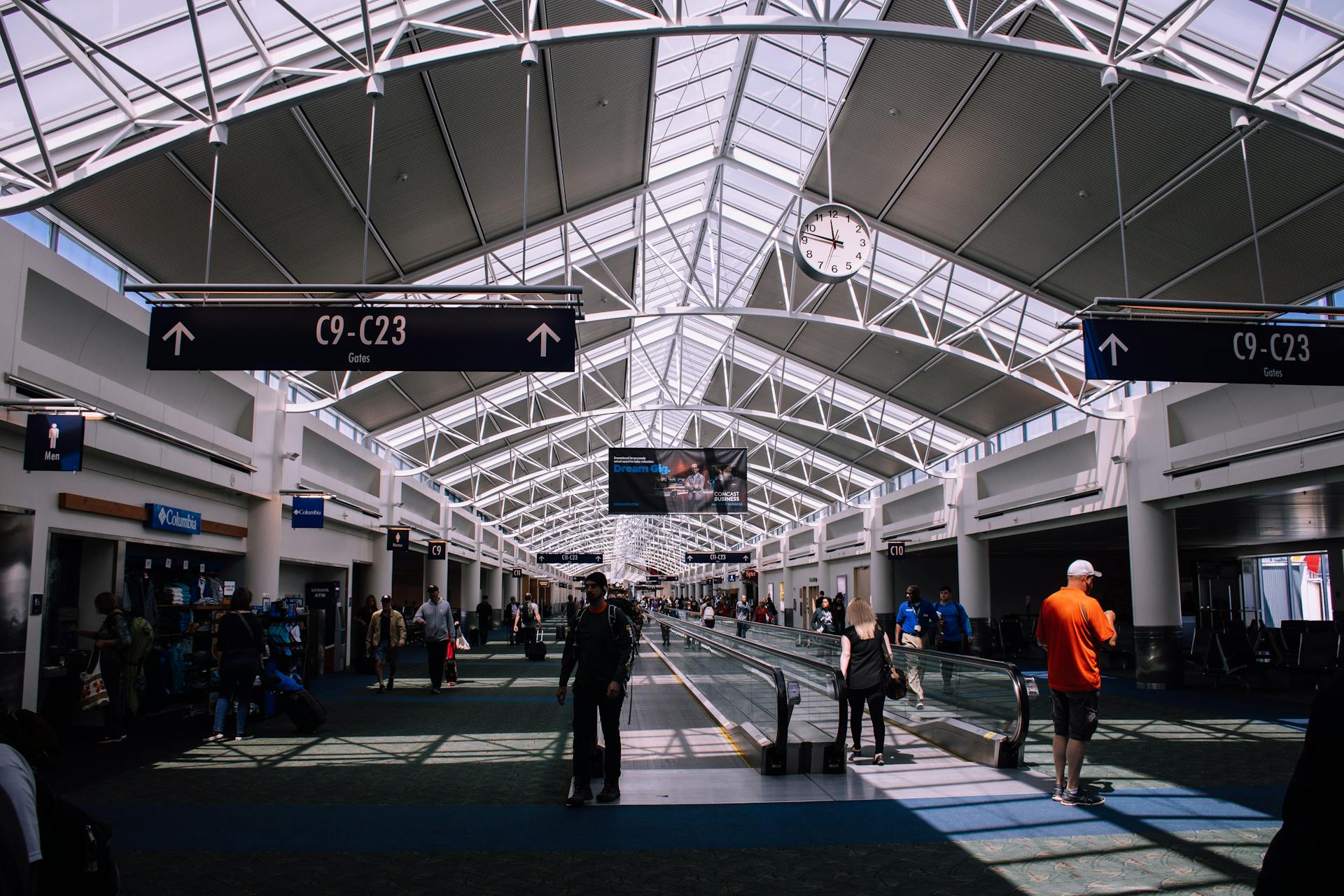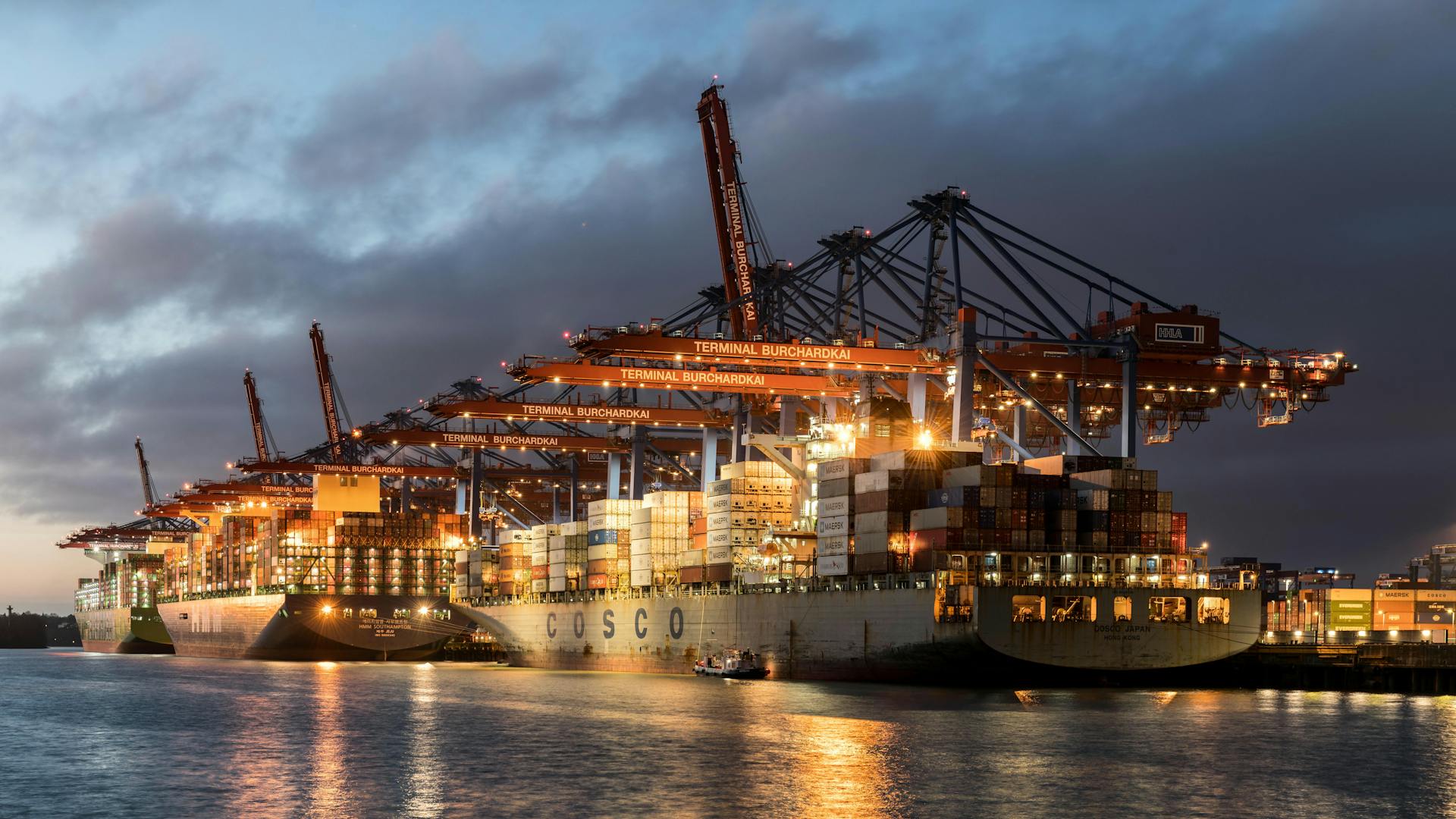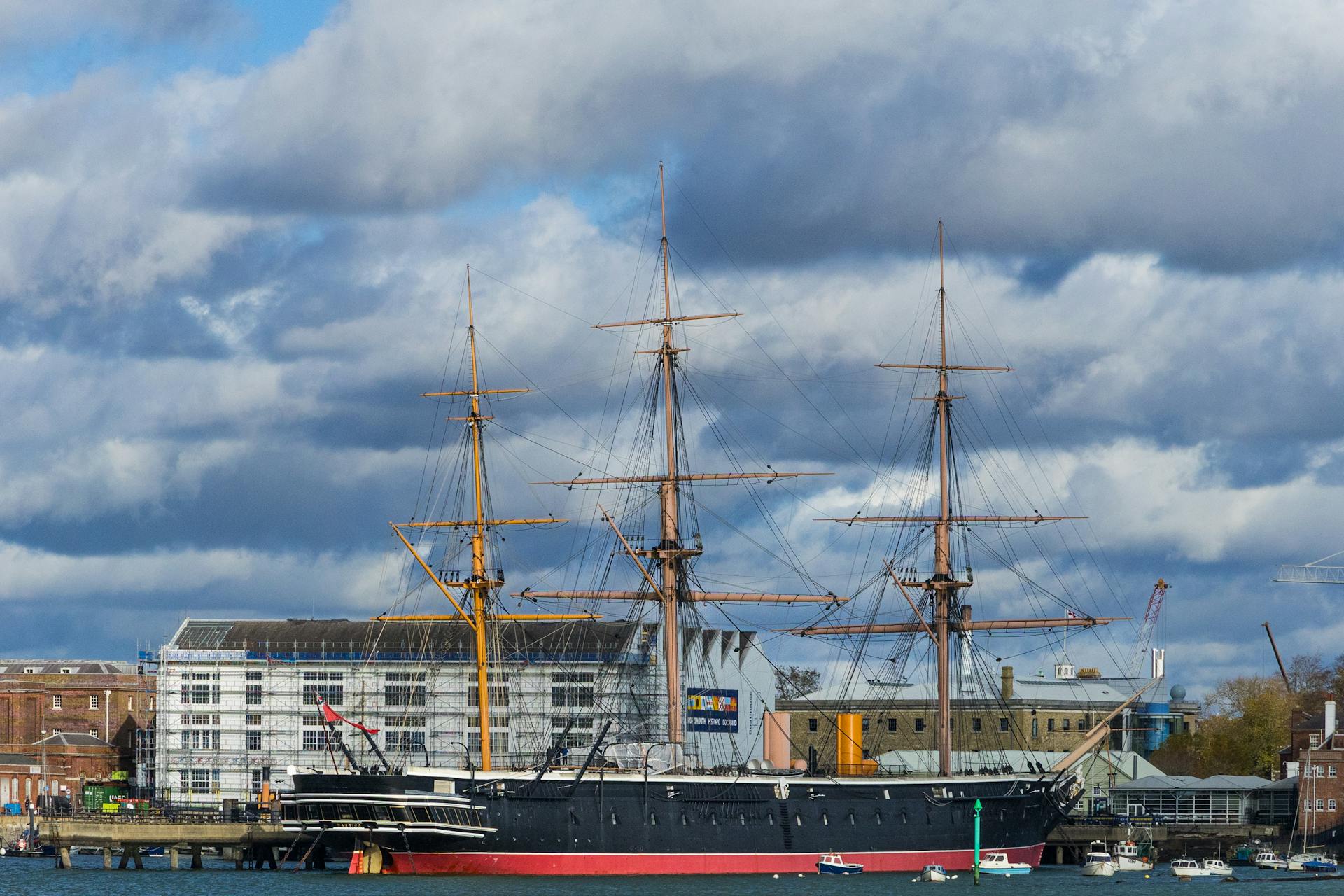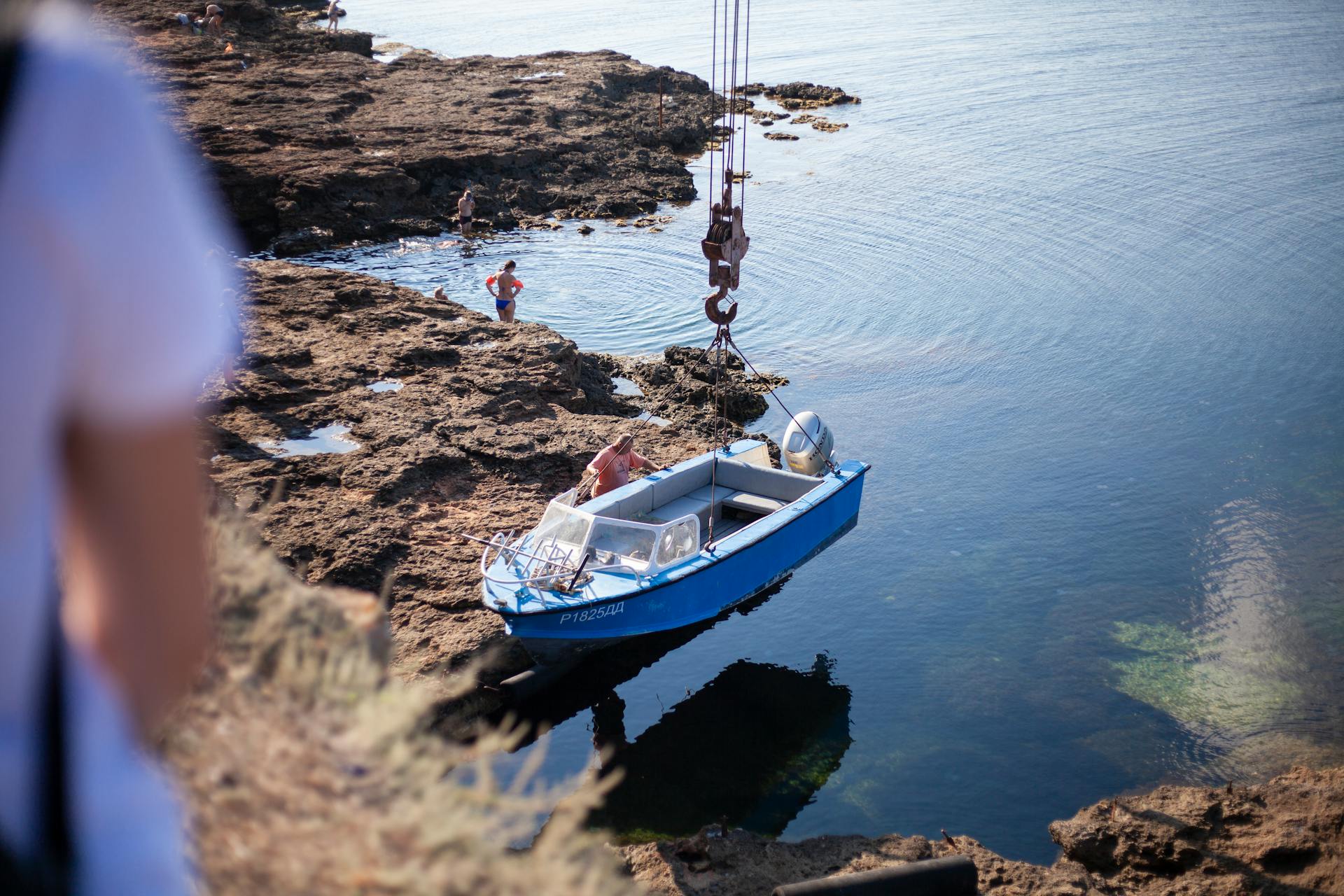
A marine commerce terminal is a crucial hub for international trade, serving as a gateway for goods to be transported by sea. These terminals are typically located near major ports and are equipped with advanced infrastructure to facilitate efficient cargo handling.
Marine commerce terminals can be either public or private, with some operating under concession agreements with governments. The Port of Rotterdam, for example, is a public terminal that handles over 460 million tons of cargo annually.
The size of a marine commerce terminal can vary greatly, ranging from small, specialized facilities to massive complexes that cover hundreds of acres. The Port of Singapore, one of the busiest terminals in the world, spans over 1,300 hectares.
A marine commerce terminal's operations are typically overseen by a terminal operator, who is responsible for managing the flow of cargo and ensuring that all necessary safety and security protocols are in place.
Advantages and Benefits
The Port of New Bedford offers a unique combination of advantages and benefits for shipping and commerce. Located within the Port of New Bedford, home to over 200 maritime businesses, this marine commerce terminal stands out from the rest.
The terminal itself is a 29-acre facility, including 21 acres of heavy-lift capacity, with uniform loading up to 4,100 psf and crane loads of up to 20,485 psf. This impressive infrastructure makes it an ideal location for handling large and heavy cargo.
One of the key benefits of shipping through the New Bedford Marine Commerce Terminal is its protected location. The U.S Army Corps Hurricane Barrier guards against storms up to Category 3 hurricanes, providing a safe and secure environment for cargo and vessels.
The terminal's accessibility is another major advantage. With 1,200 feet of bulkhead, including 800 feet of deep draft berthing and 400 feet of barge berthing space, it's easily accessible and less congested than other nearby ports. Plus, there are no height restrictions on site, and no overhead restrictions from the Terminal to open water, making it a breeze to navigate.
The terminal also offers easy roadway connections to the interstate highway system via I-95 or I-495, making it a convenient location for cargo transportation. And, as an added bonus, there is no Harbor Maintenance Tax.
Here are some key statistics about the terminal's advantages:
- 29-acre facility with 21 acres of heavy-lift capacity
- 1,200 feet of bulkhead, including 800 feet of deep draft berthing and 400 feet of barge berthing space
- No height restrictions on site, and no overhead restrictions from the Terminal to open water
- No Harbor Maintenance Tax
Terminal Features
The New Bedford Marine Commerce Terminal boasts a range of features that make it an ideal location for maritime businesses. The 29-acre facility has a heavy-lift capacity of up to 4,100 psf and crane loads of up to 20,485 psf.
The terminal is equipped with 1,200 feet of bulkhead, including 800 feet of deep draft berthing and 400 feet of barge berthing space. This allows for easy access and maneuverability of vessels.
The terminal's location within the Port of New Bedford offers easy roadway connections to the interstate highway system via I-95 or I-495. Additionally, the terminal is protected from storms up to Category 3 hurricanes by the U.S Army Corps Hurricane Barrier.
Here are some of the key features of the terminal:
- Ship-to-shore power outlets along the bulkhead
- Expandable electrical system, including a 3,000 amp, 480/277V, 3 phase, 4 wire system
- Fire protection, potable water and waste water disposal capabilities
- State-of-the-art Vega sector lights installed along the hurricane barrier to enhance vessel navigation
- Work and security level lighting allow for around-the-clock activities within the Designated Port Area
- U.S. Coast Guard regulated, secure maritime facility
- 750-ton mobile crane locally available
High Loading Capacity
The New Bedford Marine Commerce Terminal boasts an impressive high loading capacity, making it an ideal choice for heavy cargo operations. This is due in part to its 21-acre main facility, which can sustain uniform loads of up to 4,100 pounds per square foot.
The terminal's quayside is supported by a system of cellular cofferdams, a pile-supported marginal wharf, and geotechnical components, allowing for heavy uniform and concentrated loads. This system enables massive mobile cranes and self-propelled modular transporters (SPMTs) to operate throughout the site, increasing efficiency and providing logistical flexibility.
The terminal's high loading capacity allows for massive mobile cranes to lift heavy loads. For example, a 1,350 metric ton crane can lift a 500 metric ton load at 30 meters along the entire 1,000-foot new bulkhead.
Here are some key stats on the terminal's high loading capacity:
The terminal's high loading capacity is a major advantage for cargo operations. Its ability to handle heavy loads efficiently and safely makes it an attractive option for businesses looking for a reliable and efficient terminal.
Forms and Applications
To access the terminal's features, you'll need to submit the required forms and applications.
Submit all forms and applications to Jeannie Houde, the Terminal Manager.

You'll need to fill out the Berth Application to get started.
A Stevedore License Application is also required for certain activities.
If you need to access the terminal, you'll need to provide a Terminal Access List.
Here are the forms and applications you'll need to submit:
- Berth Application
- Stevedore License Application
- Terminal Access List
Operations and Services
At a marine commerce terminal, operations are a 24/7 affair, with cargo ships arriving and departing around the clock.
The terminal's operations are designed to handle a high volume of cargo, with some terminals processing over 1 million tons of cargo per year.
To manage this volume, terminals have a team of experienced personnel, including cargo handlers, crane operators, and terminal managers, who work together to ensure smooth and efficient operations.
A key aspect of operations is the use of advanced technology, such as automated cargo handling systems and real-time monitoring systems, to track and manage cargo movement.
MassCEC Unveils Upgrade Plans
The New Bedford Marine Commerce Terminal is getting a major upgrade. MassCEC plans to expand and upgrade the terminal, which spans 30 acres.

The upgrade is needed to maintain and increase Massachusetts's competitiveness in the offshore wind industry. The terminal will be able to provide facilities that support the increased demand for port facilities that can deploy larger, heavier offshore wind turbine components.
MassCEC's top priority is to support the growing offshore wind industry in Massachusetts through the strategic development of port infrastructure. This expansion will position the site as a long-term clean energy asset for the Commonwealth.
The New Bedford Marine Commerce Terminal is already playing a pivotal role in launching America's next major maritime industry: offshore wind energy.
Stevedoring
Stevedoring is a crucial aspect of the Marine Commerce Terminal's operations, and it's essential to understand the process.
MassCEC does not provide stevedoring services at the terminal, so you'll need to find an alternative.
Customers are welcome to use any stevedoring company they prefer, but they must first execute a Stevedoring License and get evaluated by MassCEC to ensure the stevedore is in good standing.
MassCEC can provide a list of the terminal's licensed stevedores if you request it.
Tariff Schedule

Docking at the New Bedford Marine Commerce Terminal is subject to MassCEC's Tariff Schedule, which is outlined in the New Bedford Marine Commerce Terminal Tariff Schedule No. 1 April 2016.
The Tariff Schedule is the governing document for docking rates and services at the terminal.
This schedule is updated periodically to reflect changes in docking rates and services, so it's essential to check the latest version.
You can find the most up-to-date Tariff Schedule on the MassCEC website or by contacting their office directly.
Understanding the Tariff Schedule will help you navigate the docking process and ensure a smooth experience.
Security and Safety
At the marine commerce terminal, security is a top priority. High mast lighting provides illumination for the entire main facility.
The site perimeter is lined with an 8-foot tall chain-link fence, capped with three-strand barbed wire, which helps to prevent unauthorized access.
Locked gates are available at the Potomska Street and Blackmer Street entrances, allowing for controlled access to the terminal.
MassCEC provides security staff for foreign-flagged vessels visiting the terminal, which complies with 31 CFR part 105.
U.S. Customs and Border Protection is located at the Port of Entry, 37 Second Street, New Bedford, MA 02740, and is available to assist with any customs-related matters.
Navigation and Logistics
At this marine commerce terminal, navigation is a breeze. The Terminal has no on-site height restrictions and no overhead restrictions on the route from the Terminal berth to open way in Buzzards Bay.
The distance from the Pilot Station to the Berth is a manageable 30 nautical miles, which can be covered in just 2 hours. This is a significant advantage for vessels looking to minimize transit time.
The Controlling Depth of the Federal Channel is a relatively shallow 28.6 feet MLLW, ensuring that most vessels can navigate through safely. This is further reinforced by the Controlling Depth of the Terminal Approach Channel, which is a more generous 30 feet MLLW.
Berth Area
Berth Area is a crucial aspect of navigation and logistics. Berthing on the starboard side, bow first, is a common practice.
The arrangement of bollards in the Berth Area is noteworthy. Main Berth and Southern Berth have bollards spaced 50 feet apart, alternating between 50 ton and 200 ton bollards.
This spacing allows for efficient docking and undocking of vessels. The alternating weights of the bollards provide additional support and stability.
Navigation
The Terminal in Buzzards Bay has no on-site height restrictions, giving you the freedom to navigate with ease.
The distance from the Pilot Station to the Terminal Berth is a significant 30 nautical miles, which will take around 2 hours to cover.
The Controlling Depth of the Federal Channel is a crucial 28.6 feet MLLW, ensuring a safe passage for your vessel.
You'll need to maintain a minimum Under Keel Clearance of 10% to avoid any issues during navigation.
The Terminal Approach Channel has a Controlling Depth of 30 feet MLLW, providing a comfortable margin for your vessel's draft.
Frequently Asked Questions
What does a marine terminal operator do?
A Marine Terminal Operator manages the movement of petroleum products in and out of a facility, overseeing ship arrivals and departures. They are responsible for the entire logistics process, from ship docking to product delivery.
What is the New Bedford Terminal at Masscec?
The New Bedford Marine Commerce Terminal is a cutting-edge heavy-lift cargo facility in North America, engineered for versatility. Located at MassCEC, it's a pioneering project that sets a new standard for cargo handling.
Sources
- https://www.masscec.com/masscec-focus/offshore-wind/new-bedford-marine-commerce-terminal-nbmct
- https://www.offshorewind.biz/2024/08/16/masscec-unveils-plans-to-upgrade-new-bedford-marine-commerce-terminal/
- https://www.southcoasttoday.com/story/news/2024/08/14/new-bedford-port-facility-expanding-to-support-offshore-wind/74798086007/
- https://www.gza.com/projects/new-bedford-marine-commerce-terminal
- https://www.vineyardoffshore.com/press-releases/vineyard-offshore-hosts-federal-leadership-at-new-bedford-marine-commerce-terminal
Featured Images: pexels.com


